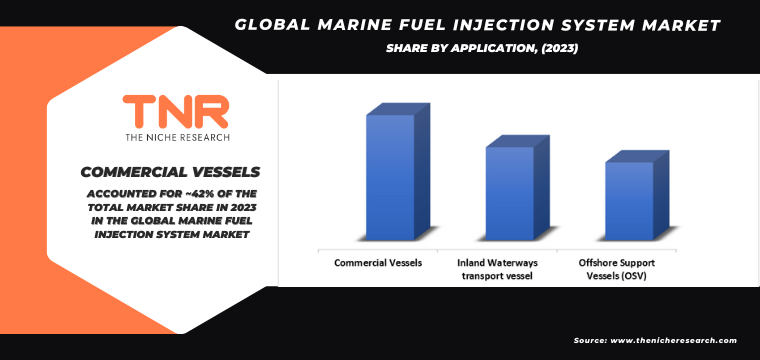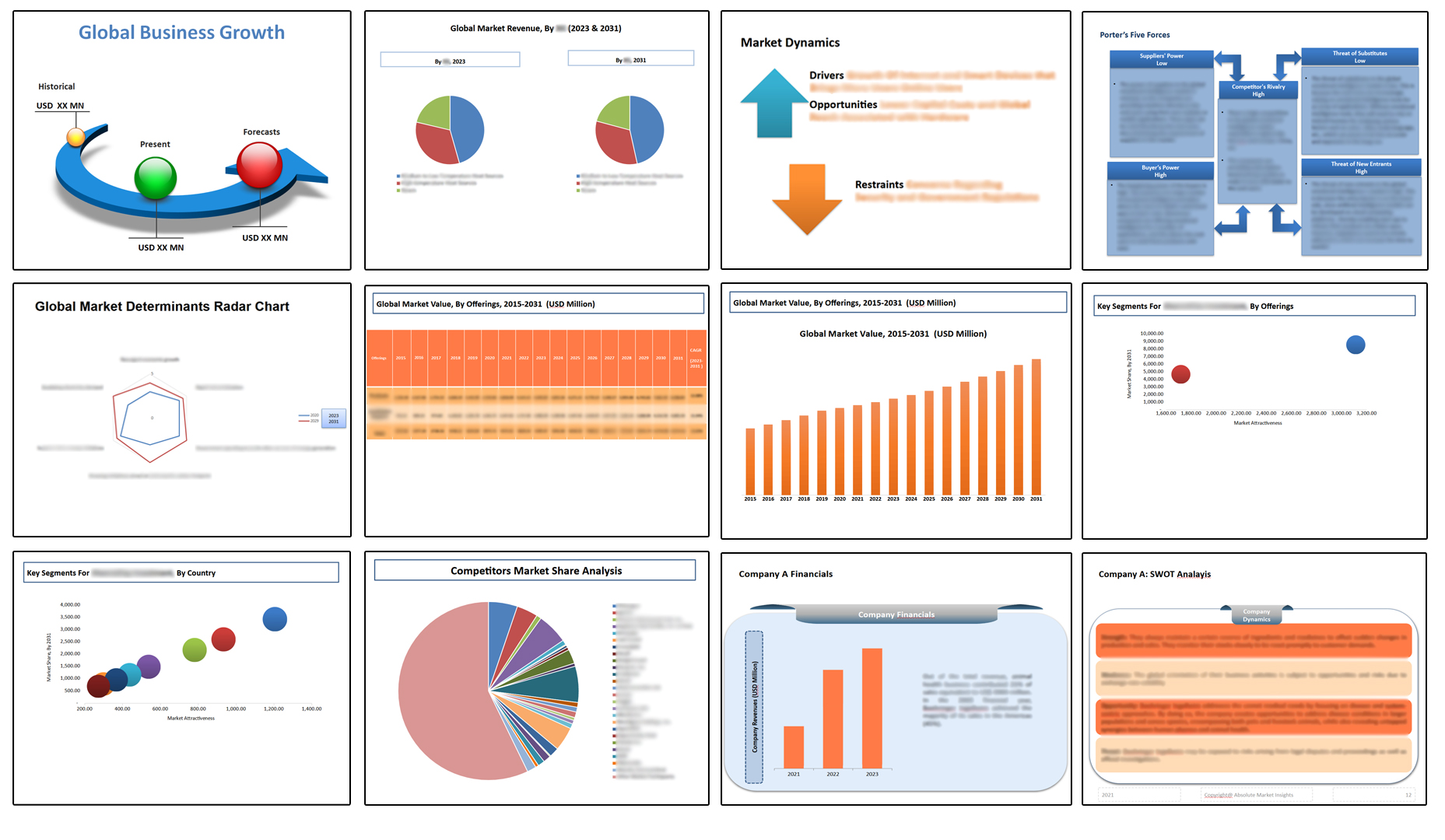Global Marine Fuel Injection System Market: By Component Type, By Engine Type, By Power Rating, By Application, By Region & Segmental Insights Trends and Forecast, 2024 – 2034
- Industry: Technology
- Report ID: TNR-110-1085
- Number of Pages: 420
- Table/Charts : Yes
- May, 2024
- Base Year : 2024
- No. of Companies : 10+
- No. of Countries : 29
- Views : 10140
- Covid Impact Covered: Yes
- War Impact Covered: Yes
- Formats : PDF, Excel, PPT
A marine fuel injection system is a critical component of a marine engine responsible for delivering fuel into the combustion chambers with precision timing and metering. It ensures efficient combustion, optimal engine performance, and reduced emissions. The fuel injector is responsible for spraying fuel directly into the combustion chamber or intake port of the engine. It atomizes the fuel into fine droplets for efficient combustion and is controlled by the engine’s electronic control unit (ECU) to precisely regulate fuel delivery according to engine load and speed.
The fuel pump delivers pressurized fuel from the fuel tank to the injectors at the required pressure. It may be a mechanical pump driven by the engine’s camshaft or an electric pump controlled by the ECU. The pump maintains fuel pressure within the system to ensure consistent fuel delivery under varying operating conditions. The fuel control unit, also known as the electronic control unit (ECU) or engine control module (ECM), is the brain of the fuel injection system. It receives input signals from various sensors such as throttle position, engine speed, and intake air temperature to calculate the optimal fuel delivery for the current operating conditions.
The FCU controls the fuel injectors’ timing, duration, and pulse width to achieve efficient combustion and engine performance.
In terms of revenue, the global marine fuel injection system market was worth US$ 5.8 Bn in 2023, anticipated to witness CAGR of 3.7% During 2024 – 2034.

Global Marine Fuel Injection System Market Dynamics
- Rising Demand for Fuel-Efficient Marine Engines: Increasing environmental concerns and stringent emissions regulations drive the demand for fuel-efficient marine engines. Marine fuel injection systems play a crucial role in optimizing fuel combustion and engine performance, thereby reducing fuel consumption and emissions. As a result, there is a growing market demand for advanced fuel injection systems capable of delivering higher efficiency and lower emissions in marine vessels.
- Technological Advancements in Fuel Injection Systems: Ongoing technological advancements in fuel injection systems enhance their performance, efficiency, and reliability. Manufacturers are developing innovative fuel injection technologies such as common rail injection, electronic unit injection (EUI), and high-pressure direct injection (HPDI) to meet the evolving needs of the marine industry. These advanced systems offer benefits such as higher injection pressures, finer fuel atomization, improved combustion control, and enhanced fuel economy, driving marine fuel injection system market growth.
- Growing Shipbuilding Activities: The global maritime industry is witnessing significant growth in shipbuilding activities, driven by increasing trade volumes, infrastructure development, and offshore exploration and production activities. Shipbuilders are integrating advanced propulsion systems and fuel-efficient technologies into new vessel designs to meet customer demands for environmentally friendly and cost-effective solutions. Marine fuel injection systems are integral components of modern marine engines, contributing to the overall efficiency and performance of newly built vessels.

Fuel Injector segment had the Highest Share in the Global Marine Fuel Injection System Market During the Forecast Period (2024 – 2034).
Fuel injectors are instrumental in enhancing the efficiency of marine engines by precisely delivering fuel into the combustion chamber in atomized form. This optimized fuel delivery ensures efficient combustion, leading to improved fuel economy and reduced emissions. As environmental regulations become more stringent and ship operators seek to minimize operational costs, there is a growing demand for fuel injectors that can deliver higher efficiency and performance.
The maritime industry is under pressure to reduce emissions to comply with regulatory standards such as the International Maritime Organization’s (IMO) MARPOL Annex VI. Fuel injectors play a crucial role in emissions reduction by promoting cleaner combustion and minimizing the release of harmful pollutants such as sulfur oxides (SOx), nitrogen oxides (NOx), and particulate matter.
As shipowners seek to meet emissions targets and mitigate environmental impact, there is an increasing need for fuel injectors that can contribute to emissions reduction efforts. The growing interest in liquefied natural gas (LNG) as a marine fuel is driving demand for fuel injectors capable of handling alternative fuels. LNG-powered vessels require specialized fuel injection systems to deliver LNG safely and efficiently into the engine’s combustion chamber. Fuel injectors designed for LNG applications must withstand the unique challenges associated with handling cryogenic temperatures and high-pressure fuel delivery, driving innovation and growth of this segment in the marine fuel injection system market.
2 Stroke Engine Segment had the Highest Share in the Global Marine Fuel Injection System Market in 2023.
Marine vessels with 2-stroke engines require fuel injection systems that can deliver precise fuel metering and injection timing to optimize engine performance. Fuel injectors play a crucial role in ensuring efficient combustion by delivering the right amount of fuel at the right time, leading to improved fuel economy, power output, and overall engine efficiency. Shipowners seek fuel injection systems that can enhance the performance of 2-stroke engines, resulting in increased demand for advanced fuel injection technologies.
Fuel injection systems for 2-stroke engines need to accommodate a wide range of fuel types and qualities, including heavy fuel oil (HFO), marine diesel oil (MDO), and low-sulfur marine fuels. As the maritime industry shifts towards cleaner fuels such as liquefied natural gas (LNG) and biofuels, there is a growing need for fuel injection systems that can handle alternative fuels effectively. Fuel injectors designed for 2-stroke engines must be capable of delivering consistent performance across different fuel compositions and viscosities, driving demand for flexible and adaptable fuel injection technologies.

By Application Commercial Vehicle Segment had the Highest Share in the Global Marine Fuel Injection System Market in 2023.
Commercial marine vehicles, including cargo ships, ferries, and tugboats, require fuel-efficient propulsion systems to reduce operational costs and comply with environmental regulations. Marine fuel injection systems play a crucial role in optimizing fuel combustion and engine performance, leading to improved fuel efficiency and reduced fuel consumption. Ship operators seek fuel injection systems that can deliver high efficiency and reliability to minimize fuel expenses and enhance profitability.
Commercial marine vehicles operate in demanding conditions, including varying sea states, heavy loads, and long voyages. Fuel injection systems must be robust, reliable, and capable of delivering consistent performance under challenging operating conditions. Shipowners prioritize fuel injection systems that offer durability, resilience, and ease of maintenance to ensure uninterrupted operation and minimize downtime, thereby maximizing vessel productivity and profitability.
The Asia-Pacific region is a major hub for maritime trade, with bustling ports and shipping lanes facilitating the movement of goods and commodities between countries. The increasing demand for marine transportation to support international trade drives the need for efficient and reliable propulsion systems in commercial vessels. Marine fuel injection systems play a critical role in optimizing engine performance and fuel efficiency, meeting the demands of the growing shipping industry in the Asia-Pacific region.
The Asia-Pacific region is experiencing rapid growth in offshore energy exploration and production activities, including oil and gas extraction, offshore wind farms, and marine renewable energy projects. Offshore support vessels, drilling rigs, and service boats operating in offshore environments require reliable and efficient propulsion systems to navigate challenging sea conditions and transport personnel and equipment. These systems offer high performance, durability, and fuel efficiency are in demand to support the expansion of offshore energy activities in the region, thus enabling demand of the marine fuel injection system market.

Competitive Landscape: Global Marine Fuel Injection System Market:
- Caterpillar Inc.
- Delphi Automotive Plc
- DENSO Corporation
- Heinzmann GmbH & Co. KG
- Liebherr International AG
- MAN SE
- Marren Fuel Injection
- OMT – Officine Meccaniche Torino SpA
- Robert Bosch GmbH
- Rolls-Royce Power Systems AG
- Suzuki Motor Corporation
- Walbro LLC
- Yanmar Co. Ltd
- Other Industry Participants
Global Marine Fuel Injection System Market Scope
| Report Specifications | Details |
| Market Revenue in 2023 | US$ 5.8 Bn |
| Market Size Forecast by 2034 | US$ 8.94 Bn |
| Growth Rate (CAGR) | 3.7% |
| Historic Data | 2016 – 2022 |
| Base Year for Estimation | 2023 |
| Forecast Period | 2024 – 2034 |
| Report Inclusions | Market Size & Estimates, Market Dynamics, Competitive Scenario, Trends, Growth Factors, Market Determinants, Key Investment Segmentation, Product/Service/Solutions Benchmarking |
| Segments Covered | By Component Type, By Engine Type, By Power Rating, By Application |
| Regions Covered | North America, Europe, Asia Pacific, Middle East & Africa, Latin America |
| Countries Covered | U.S., Canada, Mexico, Rest of North America, France, The UK, Spain, Germany, Italy, Nordic Countries (Denmark, Finland, Iceland, Sweden, Norway), Benelux Union (Belgium, The Netherlands, Luxembourg), Rest of Europe, China, Japan, India, New Zealand, Australia, South Korea, Southeast Asia (Indonesia, Thailand, Malaysia, Singapore, Rest of Southeast Asia), Rest of Asia Pacific, Saudi Arabia, UAE, Egypt, Kuwait, South Africa, Rest of Middle East & Africa, Brazil, Argentina, Rest of Latin America |
| Key Players | Caterpillar Inc.,Delphi Automotive Plc,DENSO Corporation,Heinzmann GmbH & Co. KG,Liebherr International AG,MAN SE,Marren Fuel Injection,OMT – Officine Meccaniche Torino SpA,Robert Bosch GmbH,Rolls-Royce Power Systems AG,Suzuki Motor Corporation,Walbro LLC,Yanmar Co. Ltd, Other Industry Participants |
| Customization Scope | Customization allows for the inclusion/modification of content pertaining to geographical regions, countries, and specific market segments. |
| Pricing & Procurement Options | Explore purchase options tailored to your specific research requirements |
| Contact Details | Consult With Our Expert
Japan (Toll-Free): +81 663-386-8111 South Korea (Toll-Free): +82-808- 703-126 Saudi Arabia (Toll-Free): +966 800-850-1643 United Kingdom: +44 753-710-5080 United States: +1 302-232-5106 E-mail: askanexpert@thenicheresearch.com |
Global Marine Fuel Injection System Market
By Component Type
- Fuel Injector
- Fuel Pump
- Fuel Valve
- Electronic Control Unit (ECU)
- Others
By Engine Type
- 2-Stroke
- 4-Stroke
By Power Rating
- 0 HP–2,000 HP
- 2,001 HP–10,000 HP
- 10,001 HP–20,000 HP
- 20,001 HP–50,000 HP
- 50,000 HP- 80,000 HP
- Above 80,001 HP
By Application
- Commercial Vessels
- Passenger Cruise
- Bulk Carrier & Container Ships
- Tankers
- Others
- Inland Waterways transport vessel
- Offshore Support Vessels (OSV)
By Region
- North America (U.S., Canada, Mexico, Rest of North America)
- Europe (France, The UK, Spain, Germany, Italy, Nordic Countries (Denmark, Finland, Iceland, Sweden, Norway), Benelux Union (Belgium, The Netherlands, Luxembourg), Rest of Europe)
- Asia Pacific (China, Japan, India, New Zealand, Australia, South Korea, Southeast Asia (Indonesia, Thailand, Malaysia, Singapore, Rest of Southeast Asia), Rest of Asia Pacific)
- Middle East & Africa (Saudi Arabia, UAE, Egypt, Kuwait, South Africa, Rest of Middle East & Africa)
- Latin America (Brazil, Argentina, Rest of Latin America)
Report Layout

Table of Contents
**Exclusive for Multi-User and Enterprise User.
Global Marine Fuel Injection System Market
By Component Type
- Fuel Injector
- Fuel Pump
- Fuel Valve
- Electronic Control Unit (ECU)
- Others
By Engine Type
- 2-Stroke
- 4-Stroke
By Power Rating
- 0 HP–2,000 HP
- 2,001 HP–10,000 HP
- 10,001 HP–20,000 HP
- 20,001 HP–50,000 HP
- 50,000 HP- 80,000 HP
- Above 80,001 HP
By Application
- Commercial Vessels
- Passenger Cruise
- Bulk Carrier & Container Ships
- Tankers
- Others
- Inland Waterways transport vessel
- Offshore Support Vessels (OSV)
By Region
- North America (U.S., Canada, Mexico, Rest of North America)
- Europe (France, The UK, Spain, Germany, Italy, Nordic Countries (Denmark, Finland, Iceland, Sweden, Norway), Benelux Union (Belgium, The Netherlands, Luxembourg), Rest of Europe)
- Asia Pacific (China, Japan, India, New Zealand, Australia, South Korea, Southeast Asia (Indonesia, Thailand, Malaysia, Singapore, Rest of Southeast Asia), Rest of Asia Pacific)
- Middle East & Africa (Saudi Arabia, UAE, Egypt, Kuwait, South Africa, Rest of Middle East & Africa)
- Latin America (Brazil, Argentina, Rest of Latin America)
The Niche Research approach encompasses both primary and secondary research methods to provide comprehensive insights. While primary research is the cornerstone of our studies, we also incorporate secondary research sources such as company annual reports, premium industry databases, press releases, industry journals, and white papers.
Within our primary research, we actively engage with various industry stakeholders, conducting paid interviews and surveys. Our meticulous analysis extends to every market participant in major countries, allowing us to thoroughly examine their portfolios, calculate market shares, and segment revenues.
Our data collection primarily focuses on individual countries within our research scope, enabling us to estimate regional market sizes. Typically, we employ a bottom-up approach, meticulously tracking trends in different countries. We analyze growth drivers, constraints, technological innovations, and opportunities for each country, ultimately arriving at regional figures.Our process begins by examining the growth prospects of each country. Building upon these insights, we project growth and trends for the entire region. Finally, we utilize our proprietary model to refine estimations and forecasts.
Our data validation standards are integral to ensuring the reliability and accuracy of our research findings. Here’s a breakdown of our data validation processes and the stakeholders we engage with during our primary research:
- Supply Side Analysis: We initiate a supply side analysis by directly contacting market participants, through telephonic interviews and questionnaires containing both open-ended and close-ended questions. We gather information on their portfolios, segment revenues, developments, and growth strategies.
- Demand Side Analysis: To gain insights into adoption trends and consumer preferences, we reach out to target customers and users (non-vendors). This information forms a vital part of the qualitative analysis section of our reports, covering market dynamics, adoption trends, consumer behavior, spending patterns, and other related aspects.
- Consultant Insights: We tap into the expertise of our partner consultants from around the world to obtain their unique viewpoints and perspectives. Their insights contribute to a well-rounded understanding of the markets under investigation.
- In-House Validation: To ensure data accuracy and reliability, we conduct cross-validation of data points and information through our in-house team of consultants and utilize advanced data modeling tools for thorough verification.
The forecasts we provide are based on a comprehensive assessment of various factors, including:
- Market Trends and Past Performance (Last Five Years): We accurately analyze market trends and performance data from preceding five years to identify historical patterns and understand the market’s evolution.
- Historical Performance and Growth of Market Participants: We assess the historical performance and growth trajectories of key market participants. This analysis provides insights into the competitive landscape and individual company strategies.
- Market Determinants Impact Analysis (Next Eight Years): We conduct a rigorous analysis of the factors that are projected to influence the market over the next eight years. This includes assessing both internal and external determinants that can shape market dynamics.
- Drivers and Challenges for the Forecast Period:Identify the factors expected to drive market growth during the forecast period, as well as the challenges that the industry may face. This analysis aids in deriving an accurate growth rate projection.
- New Acquisitions, Collaborations, or Partnerships: We keep a close watch on any new acquisitions, collaborations, or partnerships within the industry. These developments can have a significant impact on market dynamics and competitiveness.
- Macro and Micro Factors Analysis:A thorough examination of both macro-level factors (e.g., economic trends, regulatory changes) and micro-level factors (e.g., technological advancements, consumer preferences) that may influence the market during the forecast period.
- End-User Sentiment Analysis: To understand the market from the end-user perspective, we conduct sentiment analysis. This involves assessing the sentiment, preferences, and feedback of the end-users, which can provide valuable insights into market trends.
- Perspective of Primary Participants: Insights gathered directly from primary research participants play a crucial role in shaping our forecasts. Their perspectives and experiences provide valuable qualitative data.
- Year-on-Year Growth Trend: We utilize a year-on-year growth trend based on historical market growth and expected future trends. This helps in formulating our growth projections, aligning them with the market’s historical performance.
Research process adopted by TNR involves multiple stages, including data collection, validation, quality checks, and presentation. It’s crucial that the data and information we provide add value to your existing market understanding and expertise. We have also established partnerships with business consulting, research, and survey organizations across regions and globally to collaborate on regional analysis and data validation, ensuring the highest level of accuracy and reliability in our reports.









